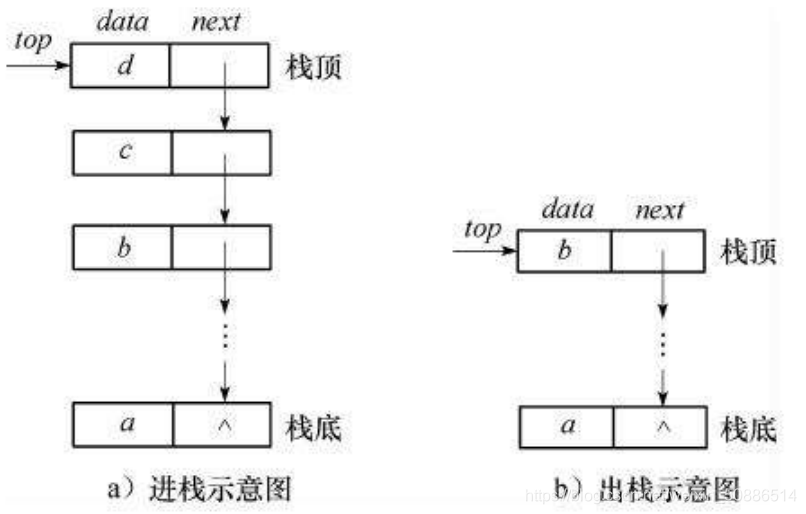table of Contents:
1. Introduction to the stack
1. The definition of the stack
Stack : A special linear table that only allows inserting and deleting elements at a fixed end. One end of the data insertion and deletion operations is called the top of the stack , and the other end is called the bottom of the stack . The data elements in the stack comply with the LIFO (Last In First Out) principle
• Push : The insertion operation of the stack is called push/ push , and the data is put on the top of the stack.
• Pop : The delete operation of the stack is called pop. The output data is also on the top of the stack.

2. Schematic diagram of the stack and pop structure
Array form:

chain structure:

According to the figure, both operations are performed at top
3. Implementation of the stack (array is recommended)
(1) Stack.h stack management and interface
#pragma once
#include<stdio.h>
#include<stdlib.h>
#include<assert.h>
typedef int STDataType;
typedef struct Stack
{
STDataType* a;//动态数组
int top; //栈顶
int capacity; //容量
}Stack;
//初始化栈
void StackInit(Stack* pst);
//销毁栈
void StackDestroy(Stack* pst);
//入栈
void StackPush(Stack* pst, STDataType data);
//出栈
void StackPop(Stack* pst);
//获取栈中有效元素的个数
int StackSize(Stack* pst);
//获取栈顶元素
STDataType StackTop(Stack* pst);
//检测栈是否为空,为空返回1,非空返回0
int StackEmpty(Stack* pst);
(2) The realization of each interface function of the Stack.c stack
#include"Stack.h"
//初始化栈
void StackInit(Stack* pst)
{
assert(pst);
pst->a = (STDataType*)malloc(sizeof(STDataType)* 4);
if (pst->a == NULL)
{
printf("malloc fail");
}
pst->top = 0;
pst->capacity = 4;
}
//销毁栈
void StackDestroy(Stack* pst)
{
assert(pst);
free(pst->a);
pst->a = NULL;
pst->top = 0;
pst->capacity = 0;
}
//入栈
void StackPush(Stack* pst, STDataType data)
{
assert(pst);
//空间不够需要增容
if (pst->top == pst->capacity)
{
//增容为原来的2倍
int* tem = (STDataType*)realloc(pst->a, sizeof(STDataType)* pst->capacity * 2);
if (tem == NULL)
{
printf("realloc fail");
exit(-1);
}
pst->a = tem;
pst->capacity = pst->capacity * 2;
}
pst->a[pst->top] = data;
pst->top++;
}
//出栈
void StackPop(Stack* pst)
{
assert(pst);
//判断栈是否为空
//相当于assert(pst->top != 0);
assert(!StackEmpty(pst));
pst->top--;
}
//获取栈中有效元素的个数
int StackSize(Stack* pst)
{
assert(pst);
//因为初始化top是0,如果初始化top是-1则返回top+1;
return pst->top;
}
//获取栈顶元素
STDataType StackTop(Stack* pst)
{
assert(pst);
assert(!StackEmpty(pst));
return pst->a[pst->top - 1];
}
//检测栈是否为空,为空返回1,非空返回0
int StackEmpty(Stack* pst)
{
assert(pst);
return pst->top == 0 ? 1 : 0;
}
(3) test.c test
#include"Stack.h"
void test()
{
//定义一个栈
Stack st;
StackInit(&st);
StackPush(&st, 1);
StackPush(&st, 2);
StackPush(&st, 3);
StackPush(&st, 4);
while (!StackEmpty(&st))
{
//取一个删一个
printf("%d ", StackTop(&st));
StackPop(&st);
}
StackDestroy(&st);
printf("\n");
}
int main()
{
test();
return 0;
}

2. Introduction to the queue
1. Definition of queue
Queue : A special linear table that only allows inserting data at one end and deleting data at the other end . The queue follows the principle of FIFO (First In First Out)
• In the queue : the end of the insert operation is called the end
of the queue • Out of the queue : the end of the delete operation is called the head of the queue

2. Implementation of the queue (recommended to use a linked list)
(1) Queue.h queue management and interface
#pragma once
#include<stdio.h>
#include<assert.h>
#include<stdlib.h>
typedef int QDatatype;
//链式结构:表示队列
typedef struct QueueNode
{
QDatatype data;
//指向下一个节点的指针
struct QueueNode* next;
}QueueNode;
//队列的结构
typedef struct Queue
{
QueueNode* front;//头指针
QueueNode* tail;//尾指针
}Queue;
//初始化队列
void QueueInit(Queue* pq);
//销毁队列
void QueueDestroy(Queue* pq);
//队尾入队列
void QueuePush(Queue* pq, QDatatype x);
//队头出队列
void QueuePop(Queue* pq);
//检测队列是否为空,为空返回1,非空返回0
int QueueEmpty(Queue* pq);
//获取队列中有效元素的个数
int QueueSize(Queue* pq);
//获取队列头部元素
QDatatype QueueFront(Queue* pq);
//获取队列队尾元素
QDatatype QueueBack(Queue* pq);
(2) Queue.c implementation of the various interface functions of the queue
#include"Queue.h"
//初始化队列
void QueueInit(Queue* pq)
{
assert(pq);
pq->front = pq->tail = NULL;
}
//销毁队列
void QueueDestroy(Queue* pq)
{
assert(pq);
QueueNode* cur = pq->front;
while (cur)
{
QueueNode* Next = cur->next;
free(cur);
cur = Next;
}
pq->front = pq->tail = NULL;
}
//队尾入队列
void QueuePush(Queue* pq, QDatatype x)
{
assert(pq);
QueueNode* newnode = (QueueNode*)malloc(sizeof(QueueNode));
newnode->data = x;
newnode->next = NULL;
if (pq->tail == NULL)
{
pq->front = pq->tail = newnode;
}
else
{
pq->tail->next = newnode;
pq->tail = newnode;
}
}
//队头出队列
void QueuePop(Queue* pq)
{
assert(pq);
//队列不能为空
assert(!QueueEmpty(pq));
//如果只有一个节点,防止tail野指针
if (pq->front == pq->tail)
{
free(pq->front);
pq->front = pq->tail = NULL;
}
//多个节点
else
{
QueueNode* Next = pq->front->next;
free(pq->front);
pq->front = Next;
}
}
//检测队列是否为空,为空返回1,非空返回0
int QueueEmpty(Queue* pq)
{
assert(pq);
return pq->front == NULL ? 1 : 0;
}
//获取队列中有效元素的个数
int QueueSize(Queue* pq)
{
assert(pq);
int count = 0;
QueueNode* cur = pq->front;
while (cur)
{
++count;
cur = cur->next;
}
return count;
}
//获取队列头部元素
QDatatype QueueFront(Queue* pq)
{
assert(pq);
assert(!QueueEmpty(pq));
return pq->front->data;
}
//获取队列队尾元素
QDatatype QueueBack(Queue* pq)
{
assert(pq);
assert(!QueueEmpty(pq));
return pq->tail->data;
}
(3) test.c test
#include"Queue.h"
void TestQueue()
{
Queue q;
QueueInit(&q);
QueuePush(&q, 1);
QueuePush(&q, 2);
QueuePush(&q, 3);
QueuePush(&q, 4);
while (!QueueEmpty(&q))
{
printf("%d ", QueueFront(&q));
QueuePop(&q);
}
printf("\n");
QueueDestroy(&q);
}
int main()
{
TestQueue();
return 0;
}
